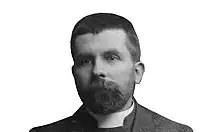Manrique Alonso Lallave | |
|---|---|
 Photo of Manrique Alonso Lallave in Madrid, 1886 for the Spanish Christian Church, now named the Spanish Anglican Church | |
| Born | February 14, 1839 |
| Died | June 5, 1889 (aged 50) |
| Nationality | Spanish people |
| Other names | Fr. Nicolás Manrique Alonso Lallave |
| Citizenship | Spanish citizenship |
| Known for | Translating the Gospel of Luke into the Pangasinan language |
| Spouse |
Carolina Ortíz Morilla
(before 1889) |
| Children | 7 |
Manrique Alonso Lallave[1] also known as Fr. Nicolás Manrique Alonso Lallave[2] was a Spanish Dominican priest well known for translating the Gospel of Luke into the Pangasinan language, the first ever known instance of a part of the Bible translated into a Philippine language.
Biography
Early life
Not much is known about Lallave's early life, he was born on February 14, 1839, in the small village of La Fuente de San Esteban,[3] near the border of Portugal and Spain, at age 14, he entered a convent of the Dominican overseas missionaries. He finished his studies in Manila and served as a Roman Catholic pastor for 12 years in the Philippine Islands.[4][3]
Conversion to Protestantism
He seems to have converted to Protestantism while in Pangasinan as the Spanish Dominican priest he received an English Bible from a British captain,[1] and/or by Protestant treaties that someone had sent him from London,[5] which caused a change causing his preachings to become "Protestant," then in 1867, Someone sent him Protestant treaties from Spain, which motivated him to be demoted and locked in a dungeon in a convent in Manila, He wrote about his conversion: “My somewhat extensive knowledge of religion has come to persuade me of the many and far-reaching mistakes of the Church of Rome, from which I have separated, freely and spontaneously, with no other purpose than to profess the truth, and using the anti-evangelical behavior of the Roman clergy in general and of the friars in particular”[lower-alpha 1] as a motive.
Later life
Because of his Protestantism, In 1872, he was removed from his position as priest and sent back to Spain where he renounced Catholicism and joined a Protestant church called the Spanish Christian Church and began his ministry in the evangelical churches of Granada and Madrid in different periods, being a pastor established in Seville from 1874 to 1888.[5]
in 1873, he translated the Gospel of Luke into the Pangasinan language, which was the first instance of a part of the Bible translated into a Philippine language, it was then published in 1877 by the British and Foreign Bible Society[5][4][3][2][1]
In Seville he became a Mason, in the Numancia 16 lodge of the Gran Oriente Luso in 1886 of the Great East Luso by 1886, being Master Founder. Later he would find Numancia 67 of the Gran Logia Sevillana and will be director of El taller, a freemason newspaper[5]
In 1877, he became a Protestant pastor. He nearly finished translating the New Testament, married Carolina Ortíz Morilla, together they had seven children.[3][1]
Death

Just before he went to Manila, Lallave passed by Madrid to see his translation printed, on March 30, 1889, he went to Manila with F. de P. Castells,[lower-alpha 2] a young Catalan Protestant pastor,[5] planning to distribute his translated Bibles, to check if his aforementioned translation in Pangasinan had arrived, create a Protestant church in the Philippines and establish an agency of the British and Foreign Bible Society. Shortly afterwards they both got sick, Lallave died and got buried, while Castells recovered and then was released from jail through the British consul's intercession, on condition that he leave the Islands immediately,[6] according to some sources[5][4] and Castells, Lallave and Castells were poisoned, this was then backed up when Lallave's daughter then claimed that 2 months after her father's death, his family received a cable and doctor's note saying that Lallave died from a fever and that his last word's were about his family, 2 messages from Manila to the family claimed that he was poisoned.[1]
Personal life
He married Carolina Ortíz Morilla in 1887,[1] together they had 7 children,[3] one of which was Miss Ether Alonso.[7]
Notes
- ↑ The original text from "ALONSO LALLAVE, MANRIQUE" (in Spanish).[3] was: “Mis conocimientos algo extensos en materia de religión me han llegado a persuadir de los muchos y trascendentales errores de la Iglesia de Roma, de la que me he separado, libre y espontáneamente, sin más objeto que profesar la verdad, y sirviéndome de móvil la conducta antievangélica del clero romano en general y de los frailes en particular”
- ↑ His full name is Francisco de Paula Castell
References
- 1 2 3 4 5 6 Kwantes, Anne C. (1989). Presbyterian missionaries in the Philippines : conduits of social change (1899-1910). Quezon City: New Day Publishers. ISBN 971-10-0360-0. OCLC 20100775.
- 1 2 Schumacher, John N. (1997). The Propaganda Movement, 1880-1895 : the creation of a Filipino consciousness, the making of the revolution (Rev ed.). Manila: Ateneo de Manila University Press. ISBN 971-550-231-8. OCLC 39026910.
- 1 2 3 4 5 6 "Alonso Lallave, Manrique". Clie (in Spanish). Retrieved 9 March 2023.
- 1 2 3 Manchado, Jose Luis. "PERSONAJES HISTÓRICOS (6) – Portalvillamayor" (in Spanish). Retrieved 9 March 2023.
- 1 2 3 4 5 6 "Protestantes del XIX, de Lallave a País". Protestante Digital (in Spanish). Retrieved 9 March 2023.
- ↑ "Batangan: How the Bible came to the Philippines". geocities.ws.
- ↑ "Missionary herald". www.familysearch.org. Retrieved 26 April 2023.